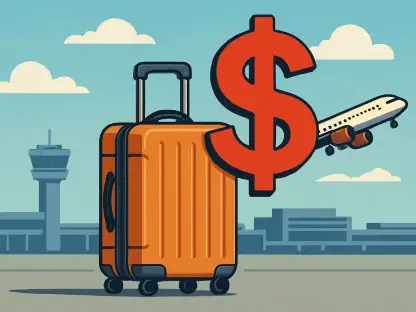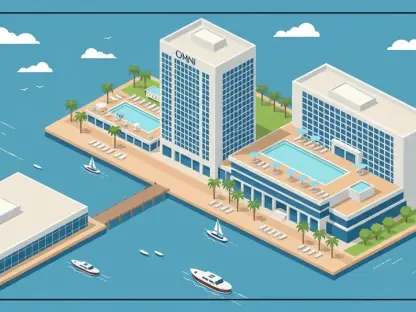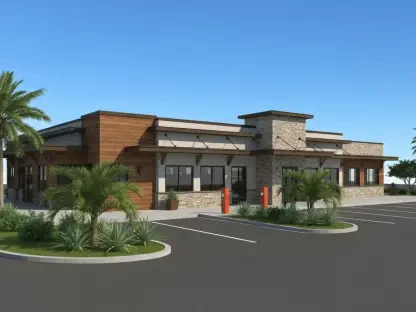Imagine a luxury beachfront hotel in Florida, its grand lobby submerged under floodwaters after yet another record-breaking hurricane, with guests evacuated and bookings canceled indefinitely. This scenario is no longer a rare nightmare but a stark reality for the hospitality sector as climate change intensifies. The industry, once focused on guest satisfaction and prime locations, now grapples with billions in annual losses from natural disasters like wildfires, floods, and heatwaves. This market analysis delves into how these environmental threats are reshaping hotel investments, operations, and long-term viability. By examining current trends, data-driven insights, and future projections, this piece aims to illuminate the urgent need for adaptation in a sector at the mercy of nature’s escalating fury. Understanding these dynamics is critical for stakeholders aiming to protect assets and seize opportunities in a rapidly evolving landscape.
Diving into Market Dynamics: Climate Impacts and Hospitality Responses
Physical Threats: Battling Nature’s Toll on Hotel Assets
The hospitality market is under siege from physical climate risks that directly threaten property integrity and profitability. Extreme weather events—hurricanes demolishing coastal resorts, wildfires engulfing mountain lodges, and floods crippling urban hotels—have become more frequent, costing the global industry billions each year in damages and downtime. Data indicates that recovery periods are lengthening, with some properties in high-risk zones facing months of lost revenue after a single event. Hotels in regions like the southeastern United States often bear the brunt, with recent storms exposing vulnerabilities in even the most fortified structures. The financial strain of repairs, coupled with disrupted operations, underscores a pressing market challenge: balancing the steep costs of preventive measures against the catastrophic losses of inaction.
Beyond immediate damage, the ripple effects on guest perception and booking patterns are reshaping market behavior. Travelers are increasingly wary of destinations prone to disasters, leading to volatile occupancy rates in affected areas. Industry reports suggest that hotels failing to demonstrate resilience—through visible infrastructure upgrades or emergency preparedness—risk losing consumer trust. This shift pushes owners to invest in robust designs, such as elevated foundations or storm-resistant materials, despite tight budgets. The market tension lies in justifying these expenditures to investors who prioritize short-term returns over long-term security, highlighting a critical pivot point for the sector’s financial strategy.
Transitional Pressures: Navigating Regulatory and Buyer Shifts
Transitional risks, though less visible than physical destruction, pose a significant threat to hotel asset valuation and market positioning. Evolving regulations, including mandates for climate impact disclosures, are forcing transparency on environmental footprints, with non-compliance risking penalties or reduced investor appeal. Market expectations are also shifting, as buyers and guests increasingly favor properties with sustainability credentials, driving up valuations for eco-certified hotels. Projections suggest that by 2027, properties lacking green features could face a valuation discount of up to 15% in competitive markets, a trend already emerging in urban centers with stringent building codes.
This market evolution compels hoteliers to anticipate future buyer priorities, integrating energy-efficient systems and sustainable practices to remain attractive. Early adopters are reaping benefits, accessing lower-cost financing and enhanced marketability, while laggards risk being saddled with devalued assets. The challenge intensifies in regions where regulatory frameworks are inconsistent, creating uncertainty for investors planning multi-year hold periods. As lenders and insurers begin factoring climate resilience into their assessments, the hospitality market must adapt swiftly to avoid being outpaced by these slower-burning but equally disruptive forces.
Regional Variations: Tailored Risks and Market Responses
Climate risks manifest differently across geographies, creating a patchwork of market challenges and responses within the hospitality sector. In California, wildfire threats and skyrocketing insurance premiums are squeezing profit margins, with some operators facing coverage costs that outstrip operational gains. Meanwhile, Texas hotels contend with dual threats of extreme heat and flooding, often struggling to secure affordable risk mitigation tools. Market data reveals that insurance costs in these high-risk zones have risen by over 20% annually since 2025, pushing smaller operators toward financial distress while larger portfolios explore innovative shared-risk programs.
Localized strategies are emerging as a key market trend, with regional building codes and community partnerships helping to address specific threats. For instance, coastal properties are investing in flood barriers, while inland hotels prioritize fire-resistant materials. However, disparities in access to capital and expertise mean that smaller players often lag behind, unable to adopt cutting-edge solutions. This uneven landscape suggests that market competitiveness may increasingly hinge on geographic adaptability, with tailored resilience plans becoming a differentiator for investors seeking to minimize exposure in volatile regions.
Emerging Trends: Sustainability and Tech as Market Game-Changers
Looking ahead, the hospitality market is witnessing a transformative shift toward proactive climate resilience, fueled by innovation and necessity. Sustainable building designs are gaining traction, with certifications for eco-friendly practices becoming a benchmark for securing favorable financing terms. Technology is also playing a pivotal role, with AI-driven weather forecasting tools enabling real-time risk mitigation, a trend projected to grow by 30% in adoption over the next two years. These advancements are not mere luxuries but essential tools for maintaining operational stability in an unpredictable environment.
Economic pressures, such as rising insurance costs, are reshaping investment patterns, particularly in high-risk zones where premiums could double by 2027. Regulatory landscapes are tightening as well, with potential mandates for stricter construction standards looming on the horizon. Market analysts predict that climate data will soon rival traditional financial metrics in investment decision-making, fundamentally altering how properties are valued and developed. Hotels that fail to integrate these trends risk obsolescence, while those embracing sustainability and technology stand to gain a competitive edge in an increasingly discerning market.
Reflecting on the Path Forward: Strategic Insights from the Analysis
Looking back, this analysis reveals how deeply climate change has reshaped the hospitality market, exposing vulnerabilities in physical assets, transitional valuations, and regional disparities. The data paints a sobering picture of an industry at a crossroads, where the cost of inaction—whether through disaster losses or eroded market appeal—has become untenable. Key implications emerge around the necessity of integrating climate resilience into every facet of operations and investment, from site selection to system upgrades. Moving forward, stakeholders should prioritize actionable steps like investing in sustainable designs to attract buyers and lower costs, leveraging technology for predictive risk management, and documenting resilience efforts to secure better insurance and financing terms. Smaller operators might consider strategic partnerships to access shared-risk programs, while investors must embed climate data into due diligence to sidestep hidden liabilities. These measures, grounded in the trends and projections discussed, offer a roadmap to not just survive but thrive amid environmental uncertainty, turning challenges into opportunities for enduring market success.









